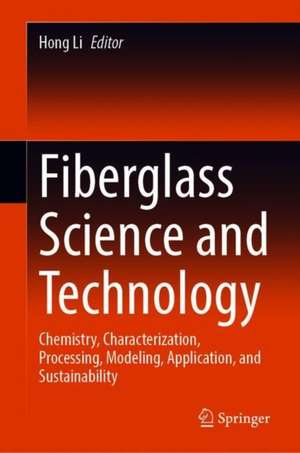Fiberglass Science and Technology: Chemistry, Characterization, Processing, Modeling, Application, and Sustainability
Editat de Hong Lien Limba Engleză Hardback – 21 aug 2021
- Advances scientific understanding of fiberglass-forming processes, rising in popularity as a building material throughout the world;
- Describes the current advances in the structure and formation of fiber glass, beginning with chemistry, a wide range of characterizations, and processes, through to applications;
- Contains information on environmental aspects of fiberglass production, addressing energy consumption and emission.
| Toate formatele și edițiile | Preț | Express |
|---|---|---|
| Paperback (1) | 919.79 lei 38-44 zile | |
| Springer International Publishing – 21 aug 2022 | 919.79 lei 38-44 zile | |
| Hardback (1) | 1077.12 lei 38-44 zile | |
| Springer International Publishing – 21 aug 2021 | 1077.12 lei 38-44 zile |
Preț: 1077.12 lei
Preț vechi: 1417.27 lei
-24% Nou
Puncte Express: 1616
Preț estimativ în valută:
206.13€ • 213.98$ • 171.88£
206.13€ • 213.98$ • 171.88£
Carte tipărită la comandă
Livrare economică 18-24 martie
Preluare comenzi: 021 569.72.76
Specificații
ISBN-13: 9783030721992
ISBN-10: 303072199X
Pagini: 551
Ilustrații: XII, 551 p. 224 illus., 144 illus. in color.
Dimensiuni: 155 x 235 mm
Greutate: 1.11 kg
Ediția:1st ed. 2021
Editura: Springer International Publishing
Colecția Springer
Locul publicării:Cham, Switzerland
ISBN-10: 303072199X
Pagini: 551
Ilustrații: XII, 551 p. 224 illus., 144 illus. in color.
Dimensiuni: 155 x 235 mm
Greutate: 1.11 kg
Ediția:1st ed. 2021
Editura: Springer International Publishing
Colecția Springer
Locul publicării:Cham, Switzerland
Cuprins
Commercial Fibers and Development.- Structure Characterizations and Simulations of Melt, Glass, and Fibers.- Surface of Glass and Glass Fibers.- Sizing Chemistry of Glass Fibers.- Fiber Forming Process.- Fiber Glass Batch-to-melt process.- Environmental Aspects of Fiber Glass Melting.- Recycling and reuse of glass fibers.
Notă biografică
Dr. Hong Li received MS degree in materials science and engineering (1989) and PhD degree in metallurgical engineering (1992). Dr. Li works as a senior scientist at Nippon Electric Glass (2017 – present). Previously, Dr. Li worked at PPG Industries, SCHOTT North America, and Pacific Northwest National Laboratory in various senior roles of developing new fiber glass, laser glass, and simulated waste glass, respectively (1994 -2017).
Dr. Li was awarded a lifetime membership of PPG Collegium Member and a Fellow of the American Ceramic Society. He chaired the Glass and Optical Materials Division (2010) and currently serves as a Council Member, International Commission on Glass. He co-edited three monographs on fundamental glass science, specialty glass, and Chinese ancient glass. Dr. Li co-authored more than 100 technical papers and has more than 110 patents/applications worldwide, covering a wide range of fiber glass and laser glass.
Dr. Li was awarded a lifetime membership of PPG Collegium Member and a Fellow of the American Ceramic Society. He chaired the Glass and Optical Materials Division (2010) and currently serves as a Council Member, International Commission on Glass. He co-edited three monographs on fundamental glass science, specialty glass, and Chinese ancient glass. Dr. Li co-authored more than 100 technical papers and has more than 110 patents/applications worldwide, covering a wide range of fiber glass and laser glass.
Textul de pe ultima copertă
This book highlights recent developments in fiberglass research and technology development, including high-performance fiberglass chemistry; in-depth glass network structure information derived from the-state-of-the-art spectroscopic measurements, molecular dynamics simulations, and their correlations with properties; fiber surface chemistry in relation to sizing chemistry - a critical part of composite performance; fiber process stability; fundamental understanding of the batch-to-melt conversion processes and melt flow simulations; and environmental concerns such as energy efficiency and emission of volatile species, which are key to environmentally-friendly product manufacturing. The book aims to guide fiberglass researchers and manufacturers towards better awareness and, perhaps, provides potential options for global ecosystem management. More than 500 current references are included, which will enable researchers from fiber glass industry and research institution access to the most recent progress in fiberglass science and technology.
- Advances scientific understanding of fiberglass-forming processes, rising in popularity as a building material throughout the world;
- Describes the current advances in the structure and formation of fiber glass, beginning with chemistry, a wide range of characterizations, and processes, through to applications;
- Contains information on environmental aspects of fiberglass production, addressing energy consumption and emission.
Caracteristici
Advances scientific understanding of fiberglass-forming processes, rising in popularity as a building material throughout the world
Describes the current advances in the structure and formation of fiber glass, beginning with chemistry, a wide range of characterizations, and processes, through to applications
Contains information on environmental aspects of fiberglass production, addressing energy consumption and emission
Describes the current advances in the structure and formation of fiber glass, beginning with chemistry, a wide range of characterizations, and processes, through to applications
Contains information on environmental aspects of fiberglass production, addressing energy consumption and emission
